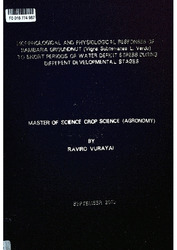| dc.description.abstract | The response pattern of morphological traits and physiological processes of bambara groundnut (Vigna Subterranean L. Verde) to short periods of water stress imposed at different growth and developmental stages and their recuperative ability after water stress were evaluated. Two greenhouse experiments were conducted in Gaborone. Botswana at in the 2009/2010 cropping season. The treatments consisted of watering plants to 100 % plant available water (PAW), withholding water to 30 % PAW at vegetative, flowering and pod filling growth stages and rewatering the plants after 21 days of each stress treatment. Water stress reduced relative water content, chlorophyll fluorescence, stomatal conductance and the reduction was more pronounced in plants stressed during the pod filling stage and less pronounced in plants stressed during the vegetative stage. Chlorophyll content was not affected by water stress at all stages of growth and development. Proline levels were increased by water stress mostly during the pod filling stage. Relative leaf expansion rate was reduced by water stress with the pod filling stage having the highest reduction. Leaf numbers, plant height and shoot: root ratio were also reduced by water stress and the reduction was highest during the vegetative stage. When plants were rewatered after each stress treatment, plants stressed during the pod filling stage failed to fully recover the relative water content and chlorophyll fluorescence. All water stressed plants at different growth stages of growth and development fully recovered stomatal conductance and proline concentration. The relative leaf expansion rate of plants stressed at pod filling and flowering stages failed to recover from water stress. Seed yield in all stressed plants was reduced by water stress due to reductions in pods per plant, seeds per pods and seed weight The highest yield amongst the stressed plants was obtained in plants stressed during the vegetative stage, followed by the flowering and lastly the pod filling stage. Bambara groundnuts appears to reduce water loss under water stress and has the ability to recover from water stress after rainfall or irrigation and is therefore capable of producing some yield under water limited conditions. | en_US |

